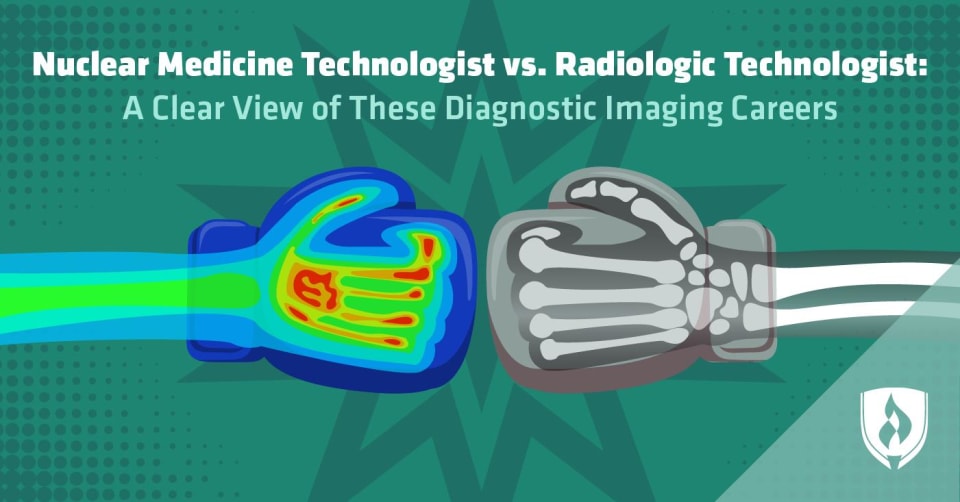Nuclear Medicine Technologist vs. Radiologic Technologist: A Clear View of These Diagnostic Imaging Careers
By Will Erstad on 08/14/2018

You’ve been on the hunt for a new career, and you know that the healthcare field would be an excellent one to plant some roots. With the Bureau of Labor Statistics (BLS) projecting robust growth of approximately 2.4 million new jobs by 2026, you’d be hard-pressed to find a more stable industry.1
After digging into some potential medical jobs, you’ve found yourself drawn toward diagnostic imaging, you likely have a few questions about some of the imaging specializations you could pursue. Two of the most common positions in this realm of healthcare are nuclear medicine technologists and radiologic technologists.
In this article, we’ll clear up any confusion you may have about these two distinct career paths as we examine how these roles overlap, the major differences between the two and what you’d need to do to land either job title.
Nuclear medicine technologist vs. radiologic technologist: What they do
At a fundamental level, the work of both nuclear medicine technologists and radiologic technologists serves a similar purpose—to create images that help healthcare professionals diagnose what’s going on with a patient. Even with comparable end goals, however, there are some substantial differences in how the professionals obtain these images.
Radiologic technologists operate sophisticated equipment that uses X-rays—a type of light ray that can pass through nonmetallic objects—to get a look at the bones and other dense masses inside of a human body. X-ray images provide a lot of helpful information, but they do have limitations.
Nuclear medical imaging is one approach for seeing what X-rays cannot reveal. Nuclear medicine technologists administer drugs with small amounts of radioactive materials to patients. These substances give off a form of radiation that can be picked up by specialized imaging equipment, giving doctors a clearer view of what is going on in organs and other soft tissues.
Both radiologic technologists and nuclear medicine technologists can expect to work closely with patients, as they’ll need to ensure patients understand the procedure and are correctly positioned for imaging devices. They also work under the supervision of doctors—radiologists and nuclear medicine physicians, respectively.
Nuclear medicine technologist vs. radiologic technologist: How to become one
Both of these healthcare roles require a fair amount of technical and medical know-how, so it shouldn’t come as a surprise that a college education is among the basic requirements for each. The Bureau of Labor Statistics (BLS) reports that radiologic technologist and nuclear medicine technologist positions typically require at least an Associate’s degree.1
It’s also worth noting that while there are still nuclear medicine technologist jobs available to those with an Associate’s degree, there has been a shift in preference toward candidates with additional education. In fact, we used real-time job analysis software to see the minimum advertised educational requirements of more than 600 nuclear medicine technologist positions from the last year; 40 percent of these postings preferred a candidate with a Bachelor’s degree.2
To work in either of these positions, you may also need to obtain certification and state licensure. The American Registry of Radiologic Technologists (ARRT) offers certification options for radiologic technologists as well as nuclear medicine technologists—though nuclear medicine technologists may opt to pursue certification from the Nuclear Medicine Technology Certification Board as well. These certification exams require applicants to pass a comprehensive test of their knowledge. In general, the requirements for certification will align closely with the requirements for state licensure, so taking the time to earn the certification is a logical step.
For those who have their sights set on working in nuclear medicine, it could be beneficial to consider first pursuing training as a radiologic technologist. From there you can spend time to building experience before eventually transitioning into a nuclear medicine program. The more diagnostic imaging specialties you have in your repertoire, the more flexibility you’ll be able to offer future employers.
Nuclear medicine technologist vs. radiologic technologist: Job outlook
If you’re considering pursuing either of these imaging specialties, the health of the job market you’ll be entering into is of obvious importance. The good news is that both radiologic technologists and nuclear medicine technologists boast fairly strong numbers.
Employment of radiologic technologists is projected to grow 12 percent by 2026. This amounts to a projected increase of 25,300 jobs. Employment of nuclear medicine technologists is also projected for growth—10 percent by 2026, leading to a projected increase of 2,000 jobs.1
The stark variance in the amount of jobs projected for these two roles can be explained by how widely applied radiographic imaging is, while images created in nuclear medicine settings are used in more specialized areas of healthcare.
With both areas considered competitive specialties, don’t be surprised if you face the need to relocate in order to find an open position.
Are you ready to work in diagnostic imaging?
Diagnostic imaging may seem like a small niche of the healthcare field, but there’s a lot to consider—and learn—when it comes to imaging specialties. The good news is that there really isn’t a wrong approach to getting started in the diagnostic imaging field. Choosing to start by pursuing a Radiologic Technologist degree doesn’t limit your horizons, as it is common for diagnostic imaging professionals to start in one specialty area and then branch out through continuing education or training programs.
If you’re interested in starting your diagnostic imaging career as a radiologic technologist, then check out Rasmussen University’s Radiologic Technologist degree page to learn more about your options.
1Bureau of Labor Statistics, U.S. Department of Labor, Occupational Outlook Handbook, [career information accessed July 27, 2018] www.bls.gov/ooh/. Data represents national, averaged earnings for the occupations listed and include workers at all levels of education and experience. Employment conditions in your area may vary.
2Burning-Glass.com (analysis of 2,362 nuclear medicine technologist job postings, July 28, 2017 – July 27, 2018)




